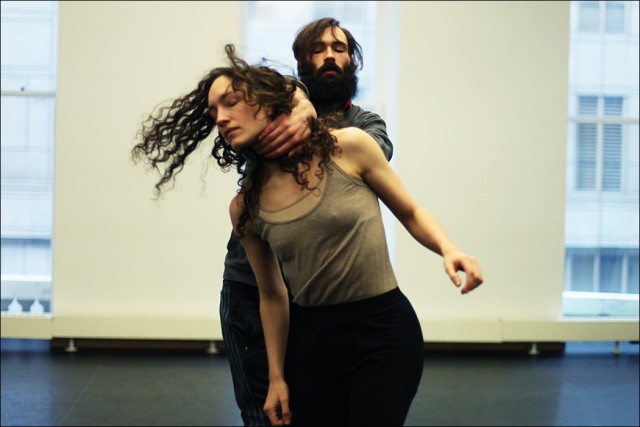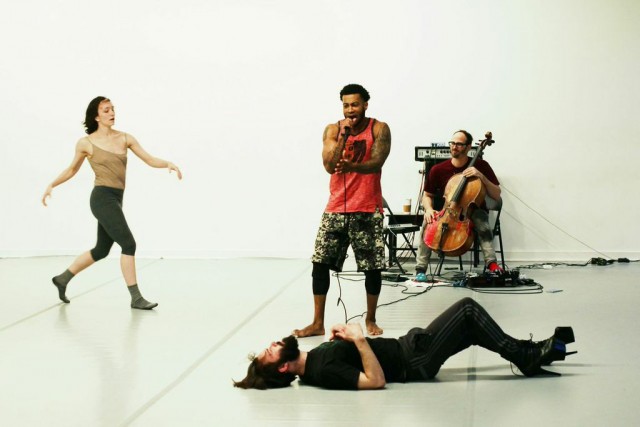
SLEEP NO MORE’s Macbeth and Lady Macbeth, Nick Bruder and Troy Ogilvie, are together again in REPLACEMENT PLACE (photo by Aeric Merideth-Goujon)
REPLACEMENT PLACE
Patricia Noworol Dance Theater
New York Live Arts
219 West 19th St. between Sixth & Seventh Aves.
April 30 – May 2, $20-$30
212-924-0077
newyorklivearts.org
pndance.com
Numerous memorable pairs have portrayed Macbeth and Lady Macbeth onstage and onscreen over the years, in various interpretations, including Laurence Olivier and Vivien Leigh, Ian McKellen and Judi Dench, Orson Welles and Jeanette Nolan, Nicol Williamson and Helen Mirren, Patrick Stewart and Kate Fleetwood, Toshiro Mifune and Isuzu Yamada, Kenneth Branagh and Alex Kingston, and Liev Schreiber and Jennifer Ehle. Nick Bruder and Troy Ogilvie might not be quite the same household names, but they appeared as the ill-fated king and his devious wife in one of the most memorable and certainly unusual versions of Macbeth you’re ever likely to see, Sleep No More, in which the action unfolds throughout the McKittrick Hotel in Chelsea. The two are back together again in Replacement Place, being presented by Patricia Noworol Dance Theater at New York Live Arts April 30 to May 2. Bruder, who won the 2011 Falstaff Award for Best Principal Performance in Sleep No More, and Ogilvie, a Juilliard graduate, New Jersey native, and Dance magazine “25 to Watch” pick in 2011, recently discussed working together and their personal and professional ideas of “place.”
twi-ny: Sleep No More has been quite a phenomenon. What was it like being part of that experience? Had you been involved in any type of interactive, participatory performances before?
Troy Ogilvie: Performing in Sleep No More was a gritty, fun, sexy ride. It was an ego trip as well as an exercise in vigilant attention. No, I had never been involved in a performance that was as immersive as SNM. My other nontraditional performance experiences were more “site specific,” as in an installation in a gallery or work done in the outdoors.
Nick Bruder: I cannot express how much I’ve learned from working with punchdrunk and Sleep No More. Mainly, I’m always going to know more about the character and the work than the audience will. And that’s okay. It’s my job to know more. If I have a clear perspective and perform with the understanding that I developed this weird alchemical-like process that actually opens up room and context for the audience to engage with — that’s imperative in Sleep No More, since it’s more likely that an audience member will catch a character’s story from unordered snippets. But this still holds true to a linear performance as well. As for other work, I’ve done a bunch of other immersive or audience-integrated work. In Los Angeles I worked with visual artist Brody Condon on two of his durational performance pieces consisting of wearing a full suit of armor and slowly falling into the floor à la a video game character’s death. Whew.
twi-ny: You played Lady Macbeth and Macbeth in Sleep No More, although you never did so at the same time. Now that you’re both in Replacement Place, do you wonder what it would have been like to have played the devious husband and wife together in Chelsea?
TO: Actually, we did fight, plot, conspire, tease, and descend into madness together for over a year as “husband” and “wife.”
twi-ny: Oops. Sorry about that.
NB: Hah. We actually ended both of our runs with Sleep No More as each other’s Macbeths. And I couldn’t think of anything better.
TO: Our bond that developed at SNM spilled over into our life outside the McKittrick Hotel, and we are always dreaming up ways to continue to work with one another.
twi-ny: Troy, you’ve worked with such choreographers as Sidra Bell, Andrea Miller, Idan Sharabi, Austin McCormick, and Margie Gillis. Do you find yourself working any differently with different choreographers, and specifically with Patricia Noworol? Do the different choreographers test you in different ways, both physically and mentally?
TO: Yes. Every choreographer has their boundary that they are — to use your word — testing. There’s something that has to stretch in the dancer in order to accommodate the weakened border, something that has to stretch but not break. The stretch is a pleasure, the skill is knowing when the boundary can be re-formed and its new shape celebrated. That moment has to do with the specific chemistry between choreographer and dancer. Patricia has a lot of openness in her process, which can be frustrating but in the end is absolutely freeing and brilliant. Anything is an option, which is a relief and a stress, but it’s exactly where I want to be right now. Pat has a great sense of timing, texture, and emotional build that we can’t wait to share with audiences.
twi-ny: Nick, you’ve appeared in opera at the Met, in a dance piece at BAC, in a mobile production at the McKittrick Hotel, in Shakespeare at the Harman Center, and now you will be at NYLA for Replacement Place. How does the concept of place inform how you approach a performance?
NB: Logistically, each site where performance is presented has its benefits: audience capacity, how close they are to the performers, size of the space, etc. Even the type of audience they attract. When one is performing in so many venues, it can begin to get exhausting adapting a changing performance approach. So I have to be confident that my understanding of character and all the tools I have collected, and some that I’ve thrown away throughout the years, can aid in helping the piece I’m in to be applicable to the venue. This may sound too heady, but I think a formula of audience + performers + space = something that happened in a place. Thinking about that, I hope, relieves the pressure of me having to adapt properly to the site and let the space and work influence the type of place it is to become.

Patricia Noworol’s REPLACEMENT PLACE is a collaboration between Troy Ogilvie, Nick Bruder, AJ “the Animal” Jonez, and Chris Lancaster (photo by Aeric Merideth-Goujon)
twi-ny: Troy, in September 2012 you wrote in Dance magazine, “I dance because it is fun. I dance because I love to perform. I dance because I always have. These clichés were all accurate at one point, but none apply today.” Do you still feel the same way?
TO: Yes, but wow, so dramatic! I mean, yes, “fun,” “love,” and “always” are not the words I would use to describe my relationship to dance, but not because it is not-fun, not-love, and not-always. I have less confusion about it now, so there’s more room to actually work and less time spent on proving myself.
twi-ny: Replacement Place features quite an eccentric collection of collaborators, from the two of you to AJ “the Animal” Jonez to electro-cellist Chris Lancaster and designer Vita Tzykun. What have the rehearsals been like? The online videos have been rather tantalizing.
TO: Rehearsals have been a blast. AJ, Chris, and Vita are experts in their fields and are also so generous with their information. We all trust each other and have fun trying on each others’ shoes — sometimes literally. I am really so pleased to be working with this group; kudos for Pat for throwing us all in a room together!
NB: They’ve been like a super-condensed story of the universe. A big bang of inspiration happens which sets ideas in motion which then leads to cool and amazing organisms to exist and grow and diversify with sunshine feeding and warming all the beautiful animals and plants when all of a sudden a little dark rain cloud comes overhead and starts spilling out its watery guts until you notice that it’s actually a black hole that is sucking you and everything you know into its gullet while you lose hope by the minute only to spit you out on the other side with a new big bang and then you’re like hmm . . . must have been a wormhole. Pretty typical artistic process. It’s awesome.
twi-ny: Whew is right. In regard to place, do each of you have somewhere you go in order to get away from it all?
TO: No. I try to be here as much as possible.
NB: I’m always in the thick of it.